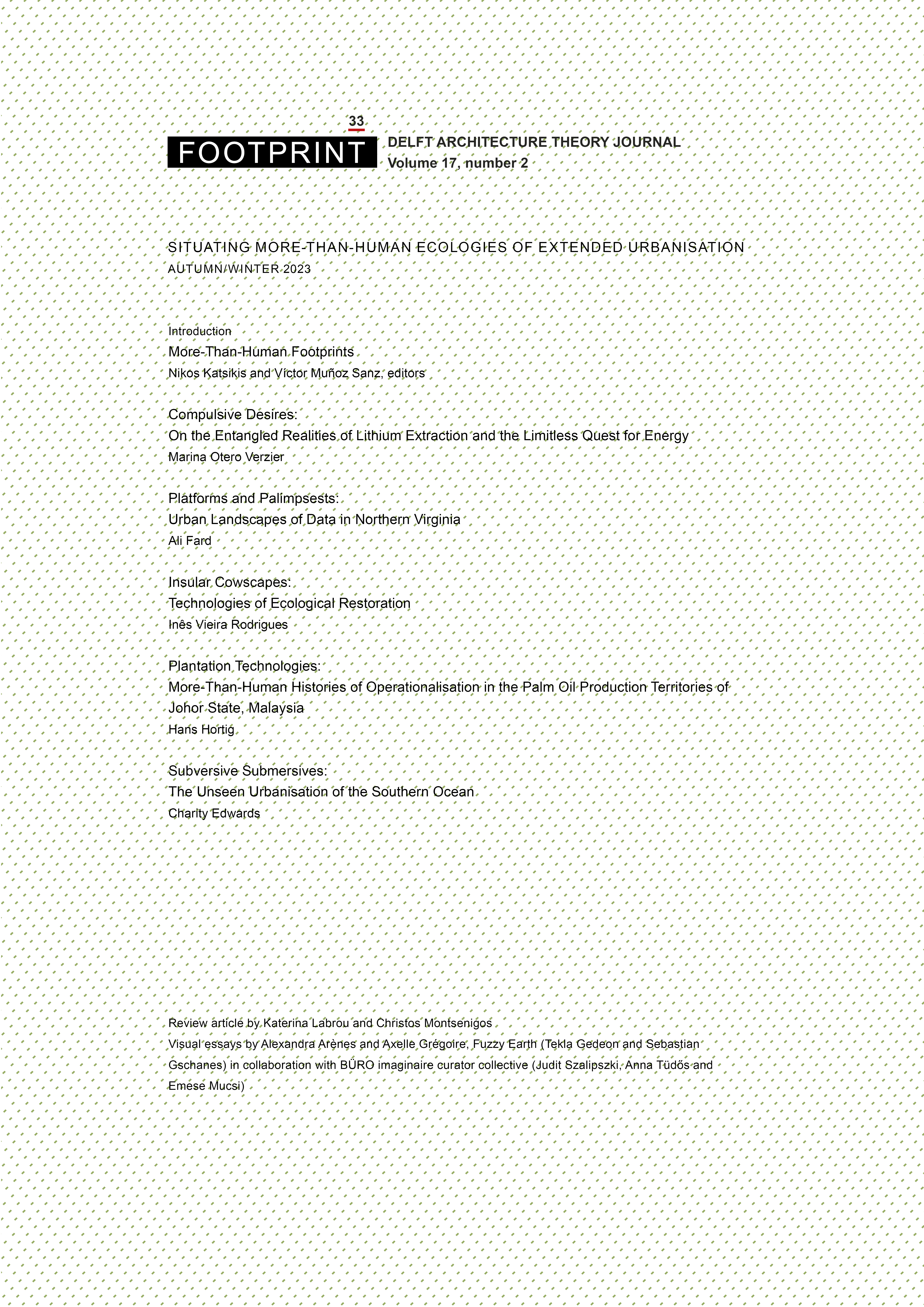In the Garden of Anthropos
Conservation after Artificial Intelligence
DOI:
https://doi.org/10.59490/footprint.17.2.6731Abstract
The term ‘planetary garden’ was coined by Gilles Clement to refer to the privileged site of the planetary mixing of species that is managed by humans. In the face of the ongoing environmental collapse, we envision the garden as a new locus for symbiotic attachment and original exchange between human and non-human ecologies. Drawing on the garden metaphor, we discuss the conceptual and ecological impacts of human stewardship of the environment. Recognising ecosystems as changing fields of social and technical interactions, we evaluate how conservation strategies shift in tandem with these changes. We explore the influence of emerging technologies on human understanding of natural ecosystems and on societal approaches to conservation. Envisioning the future, we are mapping out the need for human-centric technologies to foster new forms of agency between humans and their environments. While any technological promise does not come without ethical and technical challenges, we advocate for ecological intelligence (EI), a spatialised human-AI collaboration scheme, as a critical condition for reimagining and upscaling conservation practices in the Anthropocene.
References
Kunming-Montreal Global Biodiversity Framework. 15th meeting of the Conference of Parties to the UN Convention on Biological Diversity.
WWF. Living Planet Report 2022: Building a nature-positive society, edited by R.E.A. Almond et al. Gland, Switzerland: WWF, 2022.
The Royal Society. Multifunctional Landscapes: Informing a long-term vision for managing the UK’s land. London: Royal Society, 2023. Accessed January 2024. royalsociety.org/topics-policy/projects/living-landscapes/multifunctional-land-use/.
NASA. https://www.nnvl.noaa.gov/view/globaldata.html.
Copernicus’s Climate Data Store. https://cds.climate.copernicus.eu/cdsapp#!/software/app-era5-explorer?tab=app.
European Space Agency. https://climate.esa.int./en/.
National Science Foundation. "NSF announces 7 new National Artificial Intelligence Research Institutes." May 4, 2023. https://new.nsf.gov/news/nsf-announces-7-new-national-artificial.
Ellis, Erle C., and Navin Ramankutty. "Putting People in the Map: Anthropogenic Biomes of the World." Frontiers in Ecology and the Environment 6, no. 8 (2008): 439–47.
Ibid.
Ellis, Erle C. "Anthropogenic transformation of the terrestrial biosphere." Philosophical Transactions of the Royal Society A Mathematical Physical and Engineering Sciences 369 (2011):1010–35.
Hobbs, Richard J., Eric Higgs, Carol M Hall et al. "Novel ecosystems: theoretical and management aspects of the new ecological world order." Global Ecology and Biogeography 15 (2006): 1–7.
Ross, Matthew R.V. et al. "Designer Ecosystems: Incorporating Design Approaches into Applied Ecology." Annual Review of Environment and Resources 40 (2015): 419–43.
Marris, Emma. "Ragamuffin Earth." Nature 460 (2009): 450–53.
Wuerthner, George, Eileen Crist, and Tom Butler, eds. Keeping the Wild: Against the Domestication of Earth. Washington, DC: Foundations for Deep Ecology 3, 2014.
Wilson, Edward O. Half-Earth: Our Planet's Fight for Life. New York: Liveright Publishing Corporation, 2016.
Crist, Eileen et al. "Protecting Half the Planet and Transforming Human Systems Are Complementary Goals." Frontiers in Conservation Science, Volume 2 (2021).
Büscher, Bram, and Robert Fletcher. The Conservation Revolution: Radical Ideas for Saving Nature Beyond the Anthropocene. London and New York: Verso, 2020.
Estrada, Alejandro et al. "Global Importance of Indigenous Peoples, Their Lands, and Knowledge Systems for Saving the World’s Primates from Extinction." Science Advances 8, no. 32 (2022): 1–19.
Good Stefani, Giulia C.S. "Indigenous Leaders at the Frontlines of Environmental Injustice and Solutions." NRDC website, October 11, 2021. https://www.nrdc.org/bio/giulia-cs-good-stefani/indigenous-leaders-frontlines-environmental-injustice-and-solutions.
Broulliette, Monique. "In Alaska, Tribal Governments Push for Larger Conservation Role." Undark website, June 6, 2023. undark.org/2023/06/06/in-alaska-tribal-governments-push-for-larger-conservation-role/.
Purdy, Jedediah. After Nature: A Politics for the Anthropocene. Cambridge, MA: Harvard University Press, 2015.
Clément, Gilles. The Planetary Garden and Other Writings. Translated by Sandra Morris. Philadelphia: University of Pennsylvania Press, 2015.
Janzen, Daniel. "Gardenification of Wildland Nature and the Human Footprint." Science 279, no. 5355 (1998): 1312–13.
Bratton, Benjamin H. Terraforming. Moscow: Strelka, 2019.
Goodell, Jeff. "Is It Time to Consider Manipulating the Planet?" Yale Environment 360 website, January 7, 2009. https://e360.yale.edu/features/geoengineering_the_prospect_of_manipulating_the_planet.
Crist, Eileen. Abundant Earth: Toward an Ecological Civilization. Chicago: University of Chicago Press, 2019.
Marx, Leo. The Machine in the Garden: Technology and the Pastoral Ideal in America. Oxford: Oxford University Press, 2000.
Wägele, Wolfgang J. et al. "Towards a Multisensor Station for Automated Biodiversity Monitoring." Basic and Applied Ecology 59 (2022): 105–38.
Sun, Catherine C., Jeremy E. Hurst, and Angela K. Fuller. "Citizen Science Data Collection for Integrated Wildlife Population Analyses." Frontiers in Ecology and Evolution 9 (2021).
Tuia, Devis et al. "Perspectives in Machine Learning for Wildlife Conservation." Nature Communications 13 (2022): 792.
Cantrell, Bradley, Laura J. Martin, and Erle C. Ellis. "Designing Autonomy: Opportunities for New Wildness in the Anthropocene." Trends in Ecology & Evolution 32, no. 3 (2017): 156–66.
Cantrell, Bradley, and Zihao Zhang. "A Third Intelligence." Landscape Architecture Frontiers 6, no. 2 (2018): 42–51.
Landscape Architecture Foundation. The New Landscape Declaration, June 2016.
Corson, Catherine, and Lisa M. Campbell. "Conservation at a Crossroads: Governing by Global Targets, Innovative Financing, and Techno-Optimism or Radical Reform?" Ecology and Society 28, no. 2 (2023).
Bommasani, Rishi et al. "On the Opportunities and Risks of Foundation Models." Stanford: Center for Research on Foundation Models, 2021. arXiv:2108.07258.
Downloads
Published
Issue
Section
License
Copyright (c) 2024 Katerina Labrou, Christos Montsenigos

This work is licensed under a Creative Commons Attribution 4.0 International License.
- Authors retain copyright and grant the journal right of first publication with the work simultaneously licensed under a Creative Commons Attribution License that allows others to share the work with an acknowledgement of the work's authorship and initial publication in this journal.
- Authors are able to enter into separate, additional contractual arrangements for the non-exclusive distribution of the journal's published version of the work (e.g., post it to an institutional repository or publish it in a book), with an acknowledgement of its initial publication in this journal.





